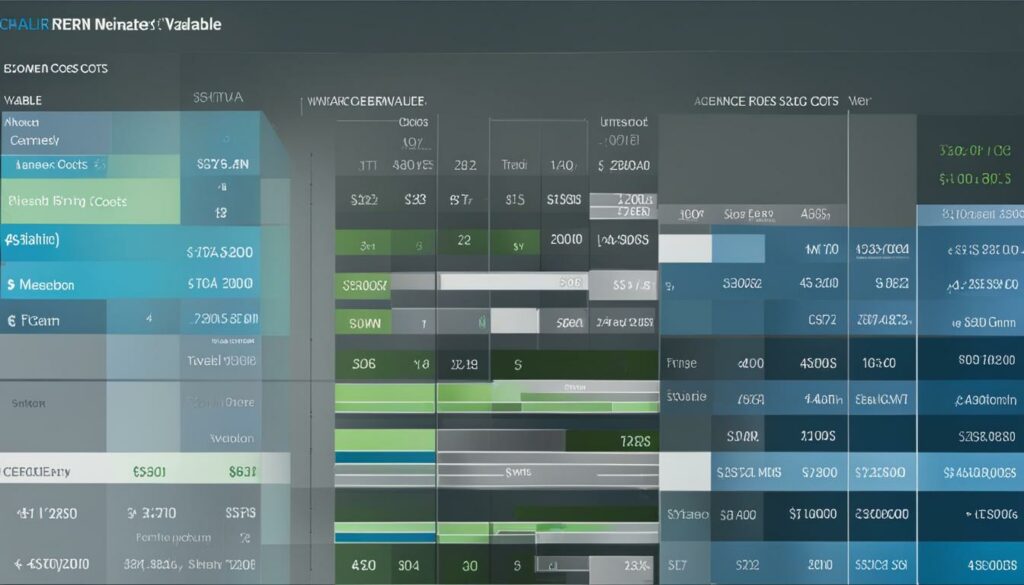Variable costs play a significant role in the financial management of ecommerce businesses. In this article, we will explore the definition of variable costs, provide examples of variable costs in ecommerce, and discuss their importance in optimizing profitability.
Variable costs, also known as direct costs, are expenses that vary in direct proportion to changes in production volume or sales. As an ecommerce business produces and sells more goods, variable costs increase. Conversely, when production and sales volume decrease, variable costs decrease as well.
Examples of variable costs in ecommerce include:
- Raw materials
- Sales commissions
- Packaging and shipping costs
- Labor costs
- Credit card fees
It is important to note that variable costs are distinct from fixed costs, which remain the same regardless of production volume. Fixed costs include expenses such as rent, salaries, and insurance premiums.
Key Takeaways:
- Variable costs in ecommerce change based on production volume or sales.
- Examples of variable costs include raw materials, sales commissions, packaging and shipping costs, labor costs, and credit card fees.
- Variable costs are different from fixed costs, which remain the same regardless of production volume.
Understanding the Difference between Variable Costs and Fixed Costs
Variable costs and fixed costs are both essential components of running a business. It is crucial to understand the distinction between these two types of costs to effectively manage and optimize profitability in ecommerce.
Variable costs are expenses that change based on production volume. As a business produces and sells more goods, these costs increase. Conversely, they decrease when production and sales volume go down. Examples of variable costs in ecommerce include raw materials, sales commissions, packaging and shipping costs, labor costs, and credit card fees.
On the other hand, fixed costs remain the same regardless of production and sales volume. They are the expenses that a business incurs regardless of its level of activity. Fixed costs can include rent, utilities, salaries, insurance, and advertising expenses.
While both variable costs and fixed costs are important, variable costs hold particular significance in ecommerce. They have a direct impact on the profitability of a business. By understanding and effectively managing variable costs, businesses can ensure consistent profitability, safeguard themselves during slow sales periods, and gain a competitive edge in the market.
“Understanding the difference between variable costs and fixed costs is crucial for managing and optimizing ecommerce profitability.”
Variable costs play a vital role in determining the break-even point and profitability of a business. A high proportion of variable costs relative to fixed costs allows for more consistent profitability since the break-even point is lower. This means that the business can cover its costs and start generating profit more quickly. Additionally, businesses with higher variable costs can dynamically adjust their production levels during periods of slow sales, protecting their profitability.
Conversely, businesses with a higher proportion of fixed costs to variable costs may require a substantial upfront investment. However, once the fixed costs are covered, they may enjoy lower competition and higher profits.
Effectively managing variable costs is essential to ensure the long-term success of an ecommerce business. By identifying and analyzing variable costs, businesses can make informed decisions and implement strategies that optimize profitability.
Importance of Variable Costs
Understanding the importance of variable costs is crucial for ecommerce businesses. Here are some key reasons why variable costs matter:
- Impact on profitability: Variable costs directly influence the overall profitability of a business. By effectively managing variable costs, businesses can maximize their profit margins and achieve sustainable growth.
- Consistent profitability: A higher proportion of variable costs relative to fixed costs can result in more consistent profitability. This is because variable costs can be adjusted based on production and sales volume, allowing businesses to remain profitable even during periods of slow sales.
- Competitive advantage: By managing variable costs effectively, ecommerce businesses can gain a competitive advantage in the market. They can offer competitive pricing, improve product quality, and invest in growth opportunities, all of which can attract more customers and increase market share.
Overall, understanding the difference between variable costs and fixed costs and recognizing the importance of variable costs is essential for optimizing ecommerce profitability. By effectively managing and analyzing variable costs, businesses can make informed decisions and implement strategies that drive long-term success.

How to Calculate Variable Costs in Ecommerce
Calculating variable costs in ecommerce is essential for understanding and managing the financial aspects of your business. By accurately determining the variable costs, you can make informed decisions, optimize profitability, and ensure the success of your ecommerce venture.
The formula to calculate variable costs is:
Total variable costs = production output x variable cost per unit
Let’s take an example to illustrate this. Suppose your company produces 10,000 units with a per-unit cost of $2.57. To calculate the total variable cost, you would multiply the production output (10,000 units) by the variable cost per unit ($2.57). The calculation would be as follows:
Total variable costs = 10,000 units x $2.57 per unit = $25,700
So, the total variable cost for producing 10,000 units at a per-unit cost of $2.57 would be $25,700.
Accurate calculation of variable costs helps you gain insights into the financial health of your business. It enables you to analyze cost structures, evaluate profitability, and make data-driven decisions to improve your ecommerce operations.

By understanding how to calculate variable costs, you can optimize your pricing strategies, streamline production processes, and effectively manage your business’s financial performance.
The Importance of Variable Costs in Ecommerce Profitability
Variable costs are a critical factor in determining the profitability of ecommerce businesses. The impact of variable costs on profitability cannot be underestimated, as they play a crucial role in shaping the financial success of a company. Understanding the importance of variable costs and their relationship to fixed costs is essential for effective cost management and long-term profitability.
Variable costs refer to business expenses that fluctuate based on production volume. These costs include raw materials, sales commissions, packaging and shipping costs, labor costs, and credit card fees. Unlike fixed costs, which remain constant regardless of production volume, variable costs increase or decrease in direct proportion to the level of production.
The importance of variable costs lies in their ability to directly impact the profitability of an ecommerce business. The proportion of variable costs to fixed costs can significantly influence the consistency of profitability. When variable costs outweigh fixed costs, businesses can achieve more consistent profitability because the break-even point is lower. This means that even during slow sales periods, businesses can reduce production and lower variable costs to protect their profitability.
On the other hand, businesses with a higher proportion of fixed costs to variable costs require a significant upfront investment. While this may result in lower competition initially, once the fixed costs are covered, these businesses can experience higher profits. However, they also face the risk of lower profitability during slow sales periods, as the fixed costs cannot be easily adjusted to match reduced production volume.

Effective management of variable costs is crucial for optimizing ecommerce profitability. By strategically analyzing and controlling variable costs, businesses can ensure the efficient allocation of resources and improve overall financial performance. This involves identifying opportunities to reduce variable costs without compromising product quality or customer satisfaction.
Furthermore, a thorough understanding of the relationship between variable costs and other metrics such as revenue, gross profit margin, and net profit margin is essential. By considering variable costs holistically alongside these metrics, businesses can make informed decisions that drive profitability. For example, analyzing the impact of variable costs on gross profit margin can help determine optimal pricing strategies to maximize profitability.
Overall, recognizing the importance of variable costs in ecommerce profitability is crucial for businesses to thrive in a competitive landscape. By effectively managing and optimizing variable costs, companies can maintain consistent profitability, protect their financial health during slow sales periods, and gain a competitive edge in the market.
Strategies to Improve Variable Cost Management in Ecommerce
Effective management of variable costs is crucial for optimizing profitability in ecommerce. By implementing strategic approaches, businesses can reduce variable costs, enhance operational efficiency, and improve the bottom line. Here are some proven strategies to help ecommerce businesses better manage their variable costs:
1. Inventory Management
Effective inventory management plays a vital role in reducing variable costs associated with holding and storing goods. By implementing inventory control systems and accurate forecasting, businesses can optimize stock levels, avoid overstocking or understocking, and reduce unnecessary storage expenses. This streamlined approach helps lower carrying costs, prevents stock obsolescence, and ensures that inventory is efficiently utilized.
2. Supplier Negotiations
Engaging in strategic supplier negotiations can have a significant impact on reducing variable costs. By leveraging purchasing power and buying in bulk, ecommerce businesses can negotiate favorable pricing and discounts. This helps drive down the variable cost per unit, ultimately improving profitability. Building strong relationships with suppliers and exploring mutually beneficial agreements can lead to long-term cost savings.
3. Optimization of Shipping and Logistics
Effective optimization of shipping and logistics can result in substantial cost savings. By partnering with reliable and cost-effective shipping providers, ecommerce businesses can reduce transportation expenses. This includes negotiating shipping rates, optimizing packaging to minimize shipping weight, and utilizing efficient fulfillment centers strategically located to minimize transit times and costs. Embracing technology-driven solutions, such as route optimization software, can further streamline logistics and lower variable costs associated with order fulfillment.
“Efficient inventory management, strategic supplier negotiations, and optimized shipping and logistics are indispensable tactics for managing variable costs in ecommerce.”
Implementing these strategies enables businesses to strike a balance between cost reduction and product quality, ensuring customer satisfaction while maximizing profitability. By continuously monitoring and evaluating variable costs, ecommerce businesses can identify areas for improvement and adopt proactive measures to optimize their variable cost management.
| Benefit | Description |
|---|---|
| Cost Reduction | Implementing effective variable cost management strategies helps reduce overall expenses, increasing profit margins. |
| Operational Efficiency | Improved management of variable costs leads to streamlined operations and reduced wastage, enhancing efficiency. |
| Competitive Advantage | By optimizing variable cost management, ecommerce businesses can gain a competitive edge by offering competitive pricing and maximizing profitability. |

Understanding Customer Behavior and its Relationship to Variable Costs
Customer behavior plays a significant role in the world of ecommerce, influencing various aspects of business operations. Notably, customer behavior can have a direct impact on the variable costs associated with running an ecommerce business. By closely examining and understanding customer behavior, businesses can effectively manage costs and optimize profitability.
Impact of Order Volume
One key aspect of customer behavior that affects variable costs is order volume. As customers place more orders, the production volume increases, which in turn leads to higher variable costs. For example, consider an ecommerce company that sells clothing. When there is a surge in orders, the company needs to source additional raw materials, hire more labor, and increase its packaging and shipping efforts to meet the demand. All these factors contribute to an increase in variable costs.
Effect of Return Rates
Return rates are another crucial factor that can significantly impact variable costs. Higher return rates mean that businesses have to allocate resources to process returns, inspect products, and restock inventory. These additional steps result in increased labor costs, additional packaging and shipping expenses, and potentially increased costs for product refurbishment or disposal. Consequently, businesses with higher return rates may experience higher variable costs.
Influence of Customer Preferences
Customer preferences also play a role in determining variable costs for ecommerce businesses. Businesses often tailor their products and services to fulfill customer preferences. However, catering to these preferences can have cost implications. For example, if customers prefer eco-friendly packaging, the business may incur higher variable costs to procure sustainable materials and apply environmentally friendly practices throughout the packaging process.
Understanding the impact of customer behavior on variable costs is vital for ecommerce businesses. By analyzing customer behavior patterns, businesses can forecast demand, adjust production and inventory levels accordingly, and implement cost management strategies. This knowledge enables businesses to optimize variable costs, maintain competitive pricing, and achieve profitable growth.
Table: Examples of Customer Behavior’s Impact on Variable Costs in Ecommerce
| Customer Behavior | Impact on Variable Costs |
|---|---|
| Higher order volume | Increased costs for raw materials, packaging, and labor |
| Higher return rates | Additional costs for return processing, restocking, and refurbishment |
| Customer preference for eco-friendly packaging | Increased costs for sustainable materials and eco-friendly practices |
Variable Costs in Relation to Other Metrics in Ecommerce
In the world of ecommerce, variable costs play a pivotal role in determining the overall profitability of a business. Understanding how variable costs relate to other metrics is essential for making informed decisions and optimizing profitability.
When it comes to analyzing the relationship between variable costs and other metrics, there are a few key factors to consider:
- Revenue: Variable costs have a direct impact on revenue. As the volume of sales increases, so do the associated variable costs. Conversely, during slower sales periods, variable costs decrease, allowing for more favorable profit margins.
- Gross Profit Margin: Variable costs are a critical component of calculating the gross profit margin. By subtracting variable costs from revenue, businesses can gauge the efficiency of their operations and identify areas for improvement.
- Net Profit Margin: Variable costs directly affect the net profit margin, which is the ultimate measure of profitability for an ecommerce business. By managing and reducing variable costs, businesses can increase their net profit margin and achieve sustainable growth.
“Understanding the relationship between variable costs and other metrics is essential for making informed decisions and optimizing profitability.”
Let’s take a closer look at how analyzing the impact of variable costs on the gross profit margin can lead to strategic pricing decisions:
| Gross Profit Margin Analysis | Variable Costs Impact | Pricing Strategy |
|---|---|---|
| High Gross Profit Margin | Low Variable Costs | Explore premium pricing strategies to maximize profitability |
| Low Gross Profit Margin | High Variable Costs | Implement cost-cutting measures or consider increasing product prices |
“Analyzing the impact of variable costs on the gross profit margin can guide businesses in determining the most lucrative pricing strategies.”
By understanding and evaluating the relationship between variable costs and other metrics, businesses can gain valuable insights into their profitability. This enables them to make data-driven decisions, optimize their operations, and ultimately achieve long-term success in the competitive world of ecommerce.
Challenges and Considerations in Managing Variable Costs in Ecommerce
Managing variable costs in ecommerce presents a unique set of challenges that require careful consideration and strategic planning. One of the key challenges is accurately forecasting demand. Fluctuations in customer purchasing behavior can make it difficult to determine the appropriate production levels, leading to either excessive inventory or stockouts. By utilizing data analysis and market research, businesses can improve their forecasting accuracy and optimize their variable cost management.
Minimizing waste and inefficiencies in production is another challenge faced by ecommerce businesses. Factors such as overproduction, inventory obsolescence, and quality issues can significantly impact variable costs. Implementing lean manufacturing practices, investing in automation technologies, and regularly reviewing and optimizing production processes can help address these challenges and reduce variable costs.
Negotiating favorable pricing with suppliers is crucial for managing variable costs effectively. Retailers need to establish strong relationships with their suppliers and explore opportunities for bulk purchasing, volume discounts, or cost-sharing arrangements. By working closely with suppliers and understanding market dynamics, businesses can secure competitive pricing that directly impacts their variable cost management.
Additionally, customer satisfaction and quality control are paramount considerations in managing variable costs. Meeting customer expectations and delivering high-quality products or services not only enhances customer loyalty but also minimizes costs associated with returns, replacements, and customer complaints. Businesses must also carefully analyze the impact of pricing decisions on profitability. Setting the right pricing strategy can help optimize variable costs and ensure sustainable profitability in the ever-changing ecommerce landscape.
FAQ
What are variable costs in ecommerce?
Variable costs in ecommerce are business expenses that change in direct proportion to production volume. These costs increase as the company produces and sells more goods, and decrease when production and sales volume decreases. Some examples of variable costs in ecommerce include raw materials, sales commissions, packaging and shipping costs, labor costs, and credit card fees.
What is the difference between variable costs and fixed costs?
Variable costs change based on production volume, while fixed costs remain the same regardless of production and sales volume. Variable costs are important because they can significantly impact the profitability of a business. Understanding and effectively managing variable costs is crucial for managing and optimizing ecommerce profitability.
How do you calculate variable costs in ecommerce?
To calculate variable costs in ecommerce, multiply the production output by the variable cost per unit. The formula to calculate variable costs is: Total variable costs = production output x variable cost per unit.
Why are variable costs important in ecommerce profitability?
Variable costs play a crucial role in shaping the profitability of ecommerce businesses. The proportion of variable costs to fixed costs can determine the consistency of profitability. By understanding and effectively managing variable costs, businesses can ensure consistent profitability, have protection during slow sales periods, and gain a competitive advantage.
What strategies can be used to improve variable cost management in ecommerce?
Ecommerce businesses can employ several strategies to improve variable cost management. These strategies include improving inventory management to reduce holding and storage expenses, negotiating favorable pricing with suppliers by purchasing in bulk, and optimizing shipping and logistics to ensure cost-effective transportation.
How does customer behavior impact variable costs in ecommerce?
Customer behavior can impact variable costs in ecommerce. Factors such as order volume, return rates, and customer preferences can affect variable costs. For example, higher order volumes can lead to increased variable costs for raw materials and packaging. Understanding customer behavior and its relationship to variable costs can help ecommerce businesses effectively manage costs and optimize profitability.
How do variable costs relate to other metrics in ecommerce?
Variable costs are closely related to other metrics in ecommerce, such as revenue, gross profit margin, and net profit margin. By analyzing and understanding the relationship between variable costs and these metrics, businesses can make informed decisions to optimize profitability.
What are the challenges and considerations in managing variable costs in ecommerce?
Managing variable costs in ecommerce comes with challenges such as forecasting demand accurately, minimizing waste and inefficiencies in production, and negotiating favorable pricing with suppliers. Additionally, businesses must consider factors such as customer satisfaction, quality control, and the impact of pricing decisions on profitability. Continuously evaluating and adapting variable cost management strategies is important for overcoming these challenges and optimizing ecommerce profitability.
